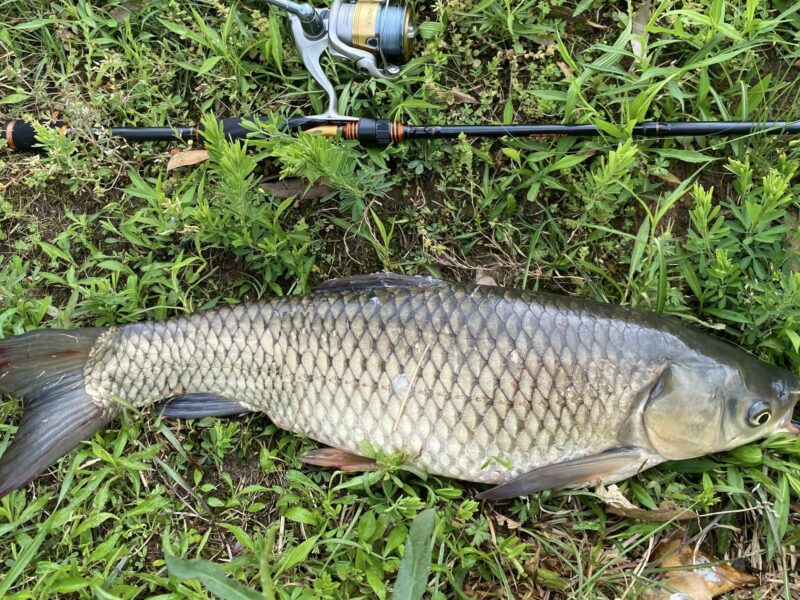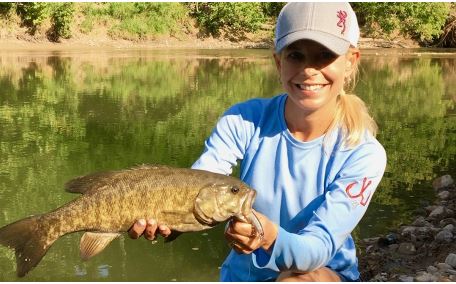How To Catch Grass Carp Like a Pro: Expert Tips and Techniques
Catching grass carp can be a challenging but rewarding experience. These fish are known for their size and strength, making them a prized catch for anglers.
Grass carp, native to East Asia, have been introduced worldwide for vegetation control in water bodies. They are herbivorous fish, primarily feeding on aquatic plants. To catch these elusive fish, you need the right strategy and preparation. In this guide, we will share tips and techniques to help you catch grass carp like a pro.
Whether you are a beginner or an experienced angler, these insights will improve your chances of success. Get ready to learn the secrets of catching grass carp and make your next fishing trip a memorable one.
Choosing The Right Gear
Choosing the right gear is crucial for catching grass carp like a pro. The right equipment ensures you have a successful fishing trip. This section covers key elements of your gear: rod and reel selection and the best fishing line. Let’s dive in and get you ready for your next adventure.
Rod And Reel Selection
The rod and reel are the foundation of your fishing setup. For grass carp, choose a medium-heavy rod. This type offers the strength needed to handle large fish. A rod length of 7 to 9 feet is ideal. It provides the leverage and control required for casting and reeling in grass carp.
For the reel, a spinning reel is the best choice. It offers ease of use and versatility. Look for a reel with a smooth drag system. This feature helps you manage the fight with a strong fish. A reel with a line capacity of at least 200 yards is recommended. Grass carp can run long distances, and you need enough line to handle that.
Best Fishing Line
The fishing line connects you to your catch. Choosing the right line is essential. Monofilament line is a great option for grass carp. It has stretch, which helps absorb shock during the fight. A line strength of 15 to 20 pounds is suitable. It provides the needed durability without being too heavy.
Braid line is another good choice. It offers high strength and low stretch. This type of line helps you feel even the slightest bites. A braided line with a strength of 30 to 50 pounds is ideal. It ensures you can handle the powerful runs of grass carp. Always use a leader with braid line. A fluorocarbon leader is best. It is nearly invisible in water and adds abrasion resistance.
By choosing the right gear, you increase your chances of a successful catch. Equip yourself with the right rod, reel, and line. You will be well on your way to catching grass carp like a pro.

Credit: www.bassgrab.com
Ideal Fishing Spots
Finding the perfect spot to catch grass carp is essential. Grass carp are elusive and selective. Choosing the right location can greatly increase your chances of success. Let’s explore some of the best places to cast your line.
Identifying Grass Carp Habitats
Grass carp prefer still or slow-moving waters. Lakes, ponds, and reservoirs are ideal. Look for areas with abundant aquatic vegetation. Grass carp feed on plants. Weedy areas are their feeding grounds. Shallow waters near the shore are prime spots. Grass carp often graze here. Watch for signs of movement. Ripples on the water surface may indicate their presence.
Best Times To Fish
Early morning and late afternoon are the best times. Grass carp are more active during these periods. They feed more aggressively. Cloudy days can also be productive. Grass carp are less wary then. Warm weather increases their activity. Spring and summer are peak seasons. Fish during these times for the best results.
Bait And Lures
Catch grass carp like a pro using the right bait and lures. Choose sweet corn, bread, or dough balls. They work best.
To catch grass carp like a pro, using the right bait and lures is essential. This section will guide you through the most effective bait options and how to use artificial lures to improve your chances of success.Effective Bait Options
Grass carp are herbivores, so using plant-based bait is crucial. Corn is one of the most effective baits for grass carp. Sweet and canned corn work well. Bread is another good choice. Mold it around your hook to attract the fish. Grass carp also love fruits and vegetables. Try using watermelon, cucumber, or lettuce. Make sure your bait is fresh. It will increase your chances of a bite.Using Artificial Lures
While live bait is effective, artificial lures can be useful too. Use lures that mimic the natural food of grass carp. Green or brown-colored lures work best. Soft plastic lures that resemble plants can attract grass carp. Cast your lure near weed beds or grassy areas. Grass carp often feed in these spots. Retrieve your lure slowly. This will mimic the natural movement of their food. Experiment with different lures and retrieval speeds. Using the right bait and lures will boost your chances of catching grass carp. Combine these tips with patience and skill for the best results. “`Casting Techniques
Casting techniques are crucial for catching grass carp effectively. Proper casting ensures your bait reaches the desired spot, increasing your chances of a successful catch. Two important casting methods are long-distance casting and accurate targeting. Let’s delve into each technique to improve your grass carp fishing skills.
Long-distance Casting
Long-distance casting helps you reach areas where grass carp hide. Begin by choosing the right rod and reel. Use a medium-heavy rod with a strong backbone. This rod type allows you to cast further. Pair it with a spinning reel for the best results.
Next, select the correct line. Braided lines are ideal for long casts. They are thin and strong, reducing wind resistance. Load your reel with enough line to prevent break-offs during long casts.
To cast, hold the rod at a 45-degree angle. Use a smooth, controlled motion. Release the line at the right moment to maximize distance. Practice your timing. It helps improve your casting distance over time.
Accurate Targeting
Accurate targeting is essential for landing your bait in the right spot. Start by observing the water. Look for signs of grass carp activity. These signs include ripples, bubbles, or visible fish.
Use landmarks to guide your aim. Choose a specific point on the water or the opposite bank. Aim your cast towards this point. This technique helps improve your accuracy.
Practice makes perfect. Spend time working on your aim. Try casting at targets on the water. Use floating objects or markers to practice. The more you practice, the better your accuracy will become.
Combine both casting techniques. Long-distance casting gets your bait out far. Accurate targeting ensures it lands where grass carp are feeding. Mastering these techniques increases your chances of a successful catch.
Hooking And Landing
Hooking and landing a grass carp can be a thrilling experience. These fish are known for their strength and agility. Successfully catching one requires skill and patience. In this section, we will discuss the essential steps for hooking and landing grass carp. We will cover setting the hook and reeling in grass carp.
Setting The Hook
Setting the hook properly is crucial for catching grass carp. These fish have a hard, bony mouth. A strong, sharp hook is essential. Wait until you feel a firm bite before setting the hook. A premature hook set can scare the fish away.
Follow these steps to set the hook:
- Feel the bite. Wait for a strong pull.
- Lift the rod tip sharply. Do this in one swift motion.
- Keep the line tight. Ensure the hook is firmly in place.
Using these techniques increases your chances of a successful hook set. Remember, timing is key.
Reeling In Grass Carp
Once the hook is set, it’s time to reel in the fish. Grass carp are strong and will put up a fight. Patience and technique are vital here.
Consider the following tips for reeling in grass carp:
- Keep the rod tip up. This maintains tension on the line.
- Reel in slowly. Use steady, consistent pressure.
- Let the fish run. Allow it to tire itself out.
- Avoid jerky movements. Smooth actions prevent the hook from dislodging.
As the fish gets closer, be prepared for sudden bursts of energy. Grass carp will often make a final dash when near the shore. Stay calm and maintain control.
Landing the grass carp requires a net. Use a large, sturdy net to scoop the fish. Avoid lifting it by the line alone. This can cause the hook to break free.
With practice, hooking and landing grass carp can become second nature. Follow these steps and enjoy a successful fishing trip.

Credit: www.youtube.com
Handling And Releasing
Handling and releasing grass carp properly ensures their survival. Proper techniques also help maintain the health of the fish population. Knowing how to handle and release them safely is key.
Safe Handling Methods
Use wet hands or a wet towel to handle the fish. This prevents removing their protective slime coat. Always support the fish’s body. Avoid squeezing too hard. This can damage internal organs.
Keep the fish out of water for the shortest time possible. This reduces stress. Use a soft, knotless landing net. This helps prevent injury to the scales and skin.
Proper Release Techniques
Place the fish back in the water gently. Hold it upright to help it regain balance. Move it back and forth slowly. This helps oxygenate its gills.
Wait until the fish swims away on its own. Ensure it is strong before releasing. Do not throw the fish back into the water. This can cause shock or injury.
Common Mistakes
Catching grass carp requires skill, patience, and understanding. Many anglers make common mistakes that can lead to frustration. By avoiding these errors, you can improve your chances of success.
Avoiding Overcasting
Overcasting is a frequent mistake among anglers. It happens when you cast your line too far. Grass carp often stay near the shore or in shallow waters. Casting too far places your bait out of their reach. Instead, aim to cast your line just beyond the visible weeds or grass beds.
Preventing Line Breaks
Line breaks are another common issue. Grass carp are strong and can break weak lines easily. Ensure you use a line with a high pound test. A line between 10-15 pounds is ideal.
Check your line regularly for wear and tear. Any nicks or frays can weaken the line. Replace it if needed. Also, use proper knots. The Palomar knot is one of the strongest and easiest to tie.
| Common Mistake | Solution |
|---|---|
| Overcasting | Cast near the shore or shallow waters |
| Line Breaks | Use a high pound test line and check for wear |
Advanced Strategies
Grass carp are a challenge to catch, even for experienced anglers. To improve your chances, you need advanced strategies. These techniques help you target grass carp more effectively and increase your success rate.
Using Chum Effectively
Chumming is a powerful technique to attract grass carp. It involves spreading food to draw fish to your fishing spot. Use chumming effectively to increase your chances of catching grass carp.
Here are some tips for chumming:
- Use high-quality chum like corn, bread, or specially designed fish food.
- Chum regularly to keep the fish interested and around your spot.
- Spread chum over a wide area to attract more fish.
Creating a feeding frenzy with chum can make grass carp easier to catch. Remember to keep it consistent and avoid over-chumming, which can scare the fish away.
Fishing In Weedy Areas
Grass carp love weedy areas. These spots offer them plenty of food and cover. Targeting these areas can significantly improve your chances.
Here are some strategies for fishing in weedy areas:
- Use weedless rigs to prevent snagging.
- Cast your bait near the edges of weed beds.
- Use floating baits to keep them above the weeds.
Fishing in weedy areas requires patience and skill. By using the right equipment and techniques, you can effectively target grass carp in their natural habitat.
Here is a summary of the advanced strategies:
| Strategy | Tips |
|---|---|
| Using Chum Effectively |
|
| Fishing in Weedy Areas |
|

Credit: news.orvis.com
Frequently Asked Questions
What Is The Best Bait For Grass Carp?
The best bait for grass carp includes corn, bread, and grass clippings. These baits attract grass carp effectively. Ensure the bait is fresh and natural.
Where Can I Find Grass Carp In A Lake?
Grass carp are usually found in shallow areas with abundant vegetation. Look for them near weed beds and submerged plants.
What Fishing Techniques Work For Grass Carp?
Float fishing and bottom fishing work well for grass carp. Use light tackle and be patient. Grass carp are cautious fish.
What Time Of Day Is Best For Grass Carp Fishing?
Early morning and late evening are the best times for grass carp fishing. During these times, they are more active and feeding.
Conclusion
Catching grass carp like a pro is achievable with patience and practice. Use the right bait and gear. Observe their habits and choose your spot wisely. Timing matters. Early morning or late evening works best. Always stay quiet and calm.
Enjoy the process and the outdoors. With these tips, you’ll soon be reeling in grass carp successfully. Happy fishing!



